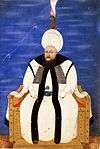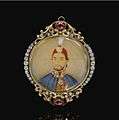Manas family
The Manas Family were an Ottoman-Armenian family that provided Imperial Portraitists to the Sultans of the Ottoman Empire in the later half of the 19th century.[1][2] Some were also chief secretaries to the Ottoman Embassy in Paris and others were music composers.[3]
The family
The family were Armenians[2] who settled in Istanbul in the 16th century and is believed to be originally from Cappadocia near Kayseri.[4][5] The family eventually provided successive imperial portraitists in the following years. Family members such as Sebuh Manas (1816–1889), a brother of Rupen, and another Manas named Jozef (1835–1916) both served as imperial artists during the reigns of Mahmud II (1808–1839), Abdulmecid I (1839–1861), Abdulaziz (1861–1876) and Abdulhamit II (1876–1909).[2] Since the brothers were assigned to the Ottoman Embassy in Paris, their portraits were distributed to other embassies throughout Europe.[1]
Rafael and Manas
Rafael Manas (1710–1780) is the first member of the family to be known. As a youth he studied in Italy and upon returning to the Ottoman Empire, he was an artist for the royal court of Osman III, Mustafa III, Mahmud I.[6] Portraits by Rafael of men and women are found in the Topkapi Museum today.[7] Rafael was buried in the Edirnekapi Armenian cemetery. Rafael's son Manas continued painting. Mouradja d'Ohsson writes that a Manas Manas served as the court's chief artist as late as the reign of Abdulhamid I (1774–1789).[8] The families last name was changed to the first name of this member of the family.[5]
Zenop
Zenop Manas received his education in Italy.[5] He eventually worked as first secretary and interpreter at the Ottoman Embassy in Vienna in the 1840s.[2]
Rupen
Rupen Manas was the eldest son Zenop Manas.[4] He was the chief interpreter of the Ottoman Embassy in Paris in 1847.[1] He received a Mecidiye medal in 1854.[2] Sultan Mahmut II sent Rupen Manas to Paris for training in art.[9] He had his own portrait done in oils and then had it displayed at the Sublime Porte.[2]
Sebuh
The second son of Zenop, Sebuh Manas (1816–1889) was also sent to Paris by Mahmud II (much like his brother Rupen) to attain art training.[10] In 1858 he was working in the Ottoman embassy in Turin, where he remained for nearly 30 years.[10] Sebuh Manas became the chief portraitist for Abdulmecid and Abdulaziz.[11] He received a Mecidiye medal in 1855, a year after his brother Rupen received one.[2]
Jozef
Considered the last court painter of the family, Jozef was born in 1835 and died in 1916.[4] He is the son of Zenop Manas's brother Mgirdic.[4] During the reign of Abdulmecid I, Jozef received education in Europe and took the place of Sebuh. One of the most important works of Jozef has been the miniature portrait of the last German Empress and Prussian Queen Augusta Victoria of Schleswig-Holstein. Also among considerable significance is his oil painting of Deli Fuad Pasha.
Edgar
Edgar Manas was born on April 12, 1875 in Istanbul. He is known to be one of the three co-authors of the Turkish National Anthem, as he made the arrangements for orchestra.[12] Artistically gifted young Edgar was sent to Italy at the age of 13 to attend the Murat-Raphaelian Armenian School to study commerce.[13] While in Venice he also took piano lessons with Professor Trivellini. Upon graduating in 1894, he returned to his native city. Yet, his impulse to continue his music studies took him back to Italy, where he settled in Padua and worked with composer Luigi Bottazzo, focusing on harmony, counterpoint and fugue. Back in Constantinople, Manas pursued his music studies further. He concentrated primarily on composition by examining the classics and the works of contemporary French masters. He produced a series of piano composition in the idiom of Chopin, including "Minuet-Valse" which was published in 1905 by A. Comendinger[14] of Constantinople. During the same year, Edgar Manas conducted the Gallia choral group in a concert at Salle de fêtes de l'Union française, a local auditorium, which earned him the Order of Officier d’académie from the French government. In 1912, Manas made the acquaintance of Komitas, the founder of modern Armenian music. Although their relationship was cordial, it was not particularly close, for Manas and Komitas lived in two different aesthetic worlds.[15] Edgar Manas perhaps is best remembered for his work on İstiklal Marşı, the Turkish National Anthem. In 1932, he was commissioned by the Turkish Republic to harmonize and orchestrate the melody created by Zeki Üngör. In 1933, a choir of 160 members performed his Vatan Şarkısı (National Song) at the Tepebaşı Tiyatrosu in Istanbul. The following year, Manas arranged and published 5 Türk Halk Şarkısı (Five Turkish Folk Songs) and, in 1935, composed Danses populaires Turques (Turkish Folk Dances) for piano, published by Editions Maurice Senard in Paris. A large portion of Manas’s manuscripts is reposited at the Charents Museum of Literature and Arts of Armenia. His students included members of the Ottoman Palace, Turkish musicians, such as Hüseyin Sadeddin Arel and Dr. Suphi Ezgi,[16] and Armenian composers, including Ara Bartevian and Koharik Gazarossian. Edgar Manas died March 9, 1964 and is buried in the Armenian Catholic cemetery of Şişli in Istanbul.
Gallery
 Mustafa III by Rafayel Manas (1770s). Currently in Topkapi Saray Museum.
Mustafa III by Rafayel Manas (1770s). Currently in Topkapi Saray Museum. Portrait of Kabuli Mehmed Pasha (1850) by Rupen Manas. Currently in Victoria and Albert Museum.
Portrait of Kabuli Mehmed Pasha (1850) by Rupen Manas. Currently in Victoria and Albert Museum. Miniature portrait of Abdülmecid I by Jozef Manas
Miniature portrait of Abdülmecid I by Jozef Manas Portrait of Abdulmecid I by Rupen Manas
Portrait of Abdulmecid I by Rupen Manas
References
- 1 2 3 Shaw, Wendy M. K. (2010). Ottoman painting : reflections of western art from the Ottoman Empire to the Turkish Republic. London: I. B. Tauris. p. 38. ISBN 978-1-84885-288-4.
- 1 2 3 4 5 6 7 Kürkman, Garo (2004). Armenian painters in the Ottoman empire: 1600–1923. Istanbul: Matusalem publ. pp. 587–589. ISBN 978-975-92015-3-1.
- ↑ Öztuncay, Bahattin (2003). The Photographers of Constantinople: Text & photographs. Aygaz. p. 37. ISBN 978-975-296-051-0.
- 1 2 3 4 "Family and People". minidev.com. Retrieved 10 December 2012.
- 1 2 3 KÜÇÜKHASKÖYLÜ, Nurdan. Osmanlı Sarayında Ermeni Ressamlar: Manas Ailesi (PDF). Retrieved 10 December 2012.
- ↑ Armenag Sarkisian, Pages d'Art Armenien, (Paris, 1940)
- ↑ Renda, G. Batılılaşma dönemi Türk resim sanatı 1700–1850. Ankara: Hacettepe Üniversitesi Publications.
- ↑ Mouradja d'Ohsson. Tableau general de I'Empire Othoman, iv, 1791
- ↑ Germaner, Semra; İnankur, Zeynep; Alemdar, Zeynep İnankur ; [translated by Nigâr; Salt], Jeremy (1989). Orientalism and Turkey. Beşiktaş, İstanbul: Turkish Cultural Service Foundation. p. 81. ISBN 978-975-7522-01-0. Cite uses deprecated parameter
|coauthors=(help) - 1 2 Rogers, J.M. (2000). Empire of the Sultans : Ottoman art from the Khalili collection (4th ed.). Alexandria, Va.: Art Services International. p. 263. ISBN 978-0-88397-132-1.
- ↑ Cark, Y. G. (1953). Türk devleti hizmetinde Ermeniler, 1453–1953. Yeni Matbaa. p. 302.
- ↑ http://www.kimkimdir.gen.tr/kimkimdir.php?id=4981 Archived August 4, 2012, at the Wayback Machine.
- ↑ Ս. Թէոդորեան։Պատմութիւն Մուրատեան վարժարանի։ Paris, 1857, Vol. I.
- ↑ Bülent Alaner (1986). Osmanlı İmparatorluğu'ndan Günümüze Belgelerle Müzik Yayıncılıǧı (1876-1986). Anadol Yayıncılık. / BÜLENT ALANER'İN BU KİTABI BAŞTAN SONA İNTİHÂLDİR. BU KONUDA BKZ. YAVUZ DALOĞLU, ORKESTRA DERGİSİ, 155. SAYI, TEMMUZ 1986. /
- ↑ Ցիցիլիա Բրուտեան (1968). Սփյուռքի հայ երաժիշտները. «Հայաստան» հրատարակչություն, Երևան. p 406.
- ↑ Turkish Music Portal